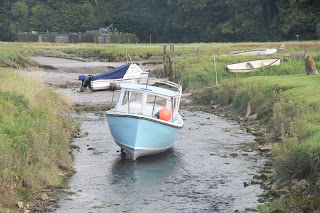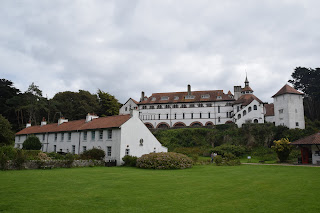Our trip North this year was geared
to the RWC but started with a little nostalgia. Helen had spent many a school holiday
in South Wales and had a hankering to return. The trip down with her own air-conditioned
front seat was in stark comparison to her earlier memories where she sat on Dad’s
lap (as the car was well overloaded) with everyone smoking.
Our first foray out was to Skomer
island - seen in the distance. Although we were too late for the puffins our
timing was perfect for the newly born white seal pups.
We opted for a boat trip along much of the island’s coastline where some seals seemed curious but this may have been a defensive position given the week old pups on the foreshore.
Just down the road from the boat
ticketing office and shop was a small building that included an outline of some
of the local wildlife. Martins had decided this was an excellent place to set
up home both in the eaves and within the rooms. Quite clearly no fear of
humans.
Our next foray was to Laugharne to
view a bit of Dylan Thomas country. His final years were spent in a boat house
in a wonderful location overlooking the River Taf, although he actually worked
in a garage slightly away from the house. This is where he wrote Under Milk
Wood an everyday story of local folk with infinitely better prose than today’s
The Archers….
We went for a 5 mile round walk which included a small part of the Welsh coastal path and ran close to this much photographed grave.
Laugharne’s focal point is its castle. We arrived just as a display of birds of prey was about to start. This was run by ‘Wings of Wales’ and was less about the birds performing and more about conservation. The first bird was a Gymogene which, when we arrived was flying around doing whatever it wanted.
It is an African Harrier Hawke but seems better related to the castles of Wales given its wonderful headgear which looks more attuned to chainmail and jousting.
The castle is a potpourri with little other than the outside walls representing any sort of planning. Random arches, filled in windows and varying levels all pointed to an ad-hoc approach. That said it does look formidable and would be quite imposing for anyone approaching be sea.
Even the tides would be a challenge to an attack with significant changes in level. Local vessels clearly need to plan their day well.
Nearby to the caravan site was the beautiful walled city of Tenby. Although busy with tourists is has a certain panache in stark comparison to the likes of Brighton or Blackpool. The colour and tidiness were apparent despite the overcast day. Although we strolled through the streets our main focus was Caldey island a 15 minute boat trip away which has been the base for Cistercian Monks for centuries.
The monastery may be relatively new (just over a century) but the original priory goes back to 1798. This includes the island’s leaning tower of Caldey!
The other significant structure is the lighthouse although the local residents were clearly not as impressed as us.
After a few short days it was
time to make our way to Poole and a ferry to Cherbourg. We did decide on a
small but fantastic detour. In Australia we had watched a short series on the
River Test presented by Richard Hammond. Part of the show included a recently opened
gin distillery which although only four years old has won many awards. I sent
them an email asking if we could pop in (with the plan to purchase a couple of
bottles) and specifically if there was room for the ‘van.
Reply – room for the ‘van and time for a tour (we have had a few Australians visit).
Not only that but the samples and tasting bottles were already lined up. Jonathan and Sarah Nelson are both ex-teachers and not missing their past life one bit. They have clearly worked hard with Jonathan doing the distillation and Sarah marketing. Sarah clearly has a great capacity to get noticed and send gins off for competition whereas Jonathan was far from convinced that what he was producing was any good! He has (rightly) overcome that worry. Each element of the production has its own fascinating story – some luck and a lot of hard work.
For instance, the bottle design reflects the clear waters of the Test flowing. As you move the bottle it seems to replicate water flowing – a brilliant design. Our education included why is a London Gin so called. Apparently if you do not add botanicals after distillation (ie get it right first time) then it is a London gin. I suspect there may be more to it than that but in itself that is quite a hurdle.
Mind you the accommodation is not too hard to get along with… The ‘garage’ where all the action occurs is on the right. Interesting large window with the original wooden structure clearly visible behind the window.
The Test water source is a chalk aquifer so is wonderfully pure and clear. An anglers delight as these clearly visible trout are very tempting but at £300 per day licences you need to be keen.
The botanical for the London gin
is meadowsweet picked on the far bank. Only a handful is needed as once dried
in the sun it has quite a strong aroma and flavour. The challenge for us was
which of the three gins to select and of course the answer was to buy all three.
Should be at least OK for the first couple of weeks on the continent!


















No comments:
Post a Comment